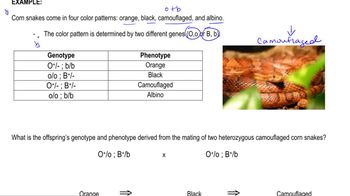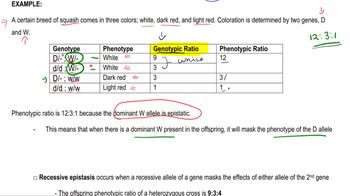Table of contents
- 1. Introduction to Genetics51m
- 2. Mendel's Laws of Inheritance3h 37m
- 3. Extensions to Mendelian Inheritance2h 41m
- 4. Genetic Mapping and Linkage2h 28m
- 5. Genetics of Bacteria and Viruses1h 21m
- 6. Chromosomal Variation1h 48m
- 7. DNA and Chromosome Structure56m
- 8. DNA Replication1h 10m
- 9. Mitosis and Meiosis1h 34m
- 10. Transcription1h 0m
- 11. Translation58m
- 12. Gene Regulation in Prokaryotes1h 19m
- 13. Gene Regulation in Eukaryotes44m
- 14. Genetic Control of Development44m
- 15. Genomes and Genomics1h 50m
- 16. Transposable Elements47m
- 17. Mutation, Repair, and Recombination1h 6m
- 18. Molecular Genetic Tools19m
- 19. Cancer Genetics29m
- 20. Quantitative Genetics1h 26m
- 21. Population Genetics50m
- 22. Evolutionary Genetics29m
3. Extensions to Mendelian Inheritance
Epistasis and Complementation
Problem 26a
Textbook Question
Two pure-breeding strains of summer squash producing yellow fruit, Y₁ and Y₂, are each crossed to a pure-breeding strain of summer squash producing green fruit, G₁, and to one another. The following results are obtained:

Examine the results of each cross and predict how many genes are responsible for fruit-color determination in summer squash. Justify your answer.
 Verified step by step guidance
Verified step by step guidance1
Examine the F1 generation results for each cross to determine the dominant and recessive traits. In Cross I, all F1 are yellow, suggesting yellow is dominant over green. In Cross II, all F1 are green, suggesting green is dominant over yellow.
Analyze the F2 generation ratios. In Cross I, the 3:1 ratio (3/4 yellow : 1/4 green) suggests a single gene with two alleles, where yellow is dominant. In Cross II, the 3:1 ratio (3/4 green : 1/4 yellow) also suggests a single gene with two alleles, where green is dominant.
Consider Cross III, where the F2 generation shows a 13:3 ratio (13/16 yellow : 3/16 green). This ratio suggests the involvement of two genes, as it deviates from the typical 3:1 ratio seen in single-gene inheritance.
Propose a genetic model: Cross I and II suggest single-gene inheritance with different dominant alleles, while Cross III suggests epistasis or interaction between two genes, leading to the 13:3 ratio.
Conclude that two genes are likely responsible for fruit color determination, with one gene showing dominance in Cross I and another in Cross II, and their interaction in Cross III leading to the observed ratios.
Recommended similar problem, with video answer:
 Verified Solution
Verified SolutionThis video solution was recommended by our tutors as helpful for the problem above
Video duration:
6mPlay a video:
Was this helpful?

 5:05m
5:05mWatch next
Master Complementation with a bite sized video explanation from Kylia Goodner
Start learning




